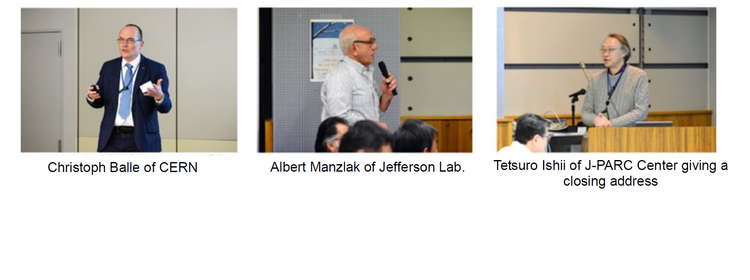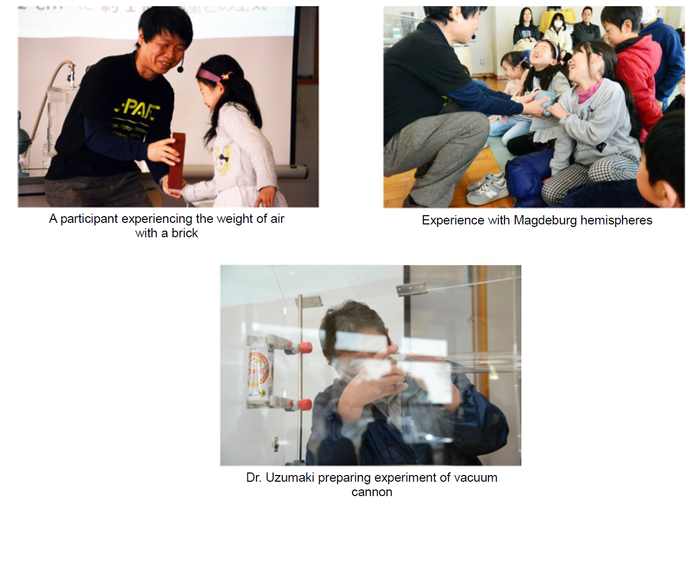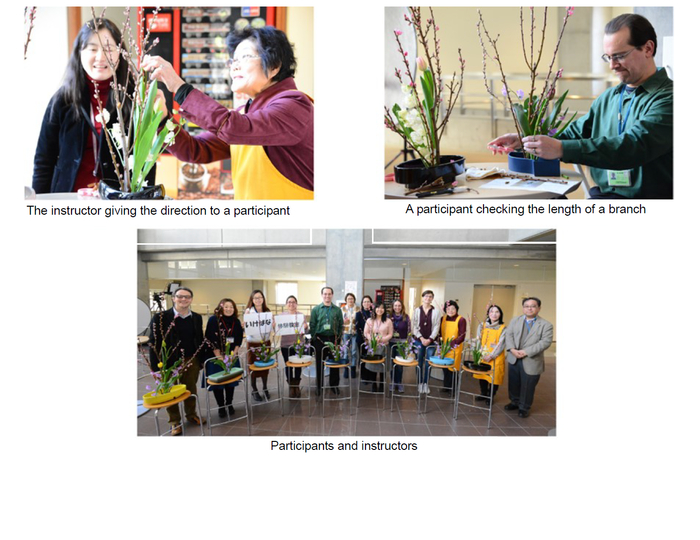J-PARC NEWS February 2018 (Issue #154)
■ 5th Symposium on Safety in Accelerator Facilities (January 25-26, IQBRC)
Annually, J-PARC holds the Symposium on Safety in Accelerator Facilities in order to improve the safety of all accelerator facilities by cooperating with interested persons in and out of Japan. This year, we had our 5th symposium, which ran for 2 days (January 25-26) at the Ibaraki Quantum Beam Research Center (IQBRC).
The symposium has covered topics such as "radioactive components", “high-pressure gas (refrigerator) facilities”, "emergency measures", and "electrical safety" so far, and we've discussed issues of safety management of the accelerator facilities. This time, "radiation safety education" and "ensuring safety in heavy object transportation" were the main themes of discussion. A total of 124 people participated: 61 were from external organizations such as accelerator facilities, universities, and corporations in Japan as well as overseas, and 63 were from J-PARC.
Following the J-PARC Director Naohito Saito's opening speech, nine seminars were given on radiation safety education and heavy load transportation. In addition, Christoph Balle (CERN※1) and Albert Manzlak (Jefferson Lab※2) from research organizations outside of Japan explained safety education and ensuring safety in experiments involving a tritium target. Furthermore, there were 18 poster presentations about accelerators, including CERN and the Jefferson Lab, and safety measures. Participants were active in exchanging information. Ishii Tetsuro, the Safety Deputy Director of J-PARC, gave the closing speech. "We hope to continue our international cooperation in order to improve the safety of accelerator facilities."
※1:European Organization for Nuclear Research (CERN, Swizerland), ※2:Thomas Jefferson National Accelerator Facility (Jefferson Lab, USA)
■ 2nd ESS J-PARC Collaboration Workshop (January 18-19, Lund, Sweden)
The large-scale 5 MW spallation neutron source facility (ESS *), a project in which J-PARC is collaborating with 17 European countries, is currently under construction in the outskirts of Lund city. It is hoped that the accelerator operation and its use among organizations will start in 2019. The J-PARC Center signed a cooperation agreement concerning the ESS development. J-PARC Director Naohito Saito and nine others participated in the second meeting held in Lund. From ESS, about 30 researchers and engineers participated. ESS Director John Womersley gave an overview of the project and reported that the construction has progressed as much as 40%. The group from J-PARC took a tour of the construction site, and then exchanged information on the accelerator, neutron sources, etc. at ESS headquarters. Since the researchers shared a common goal of building an advanced facility, they confirmed their commitment to share experience and knowledge in order to help each other for further development. ※ :European Spallation Source
■ Kenji Kojima from Muon Science Section was awarded the “Koshiba Prize” (February 13, Arcadia Ichigaya, Tokyo)
On February 13, the ceremony was held at Arcadia Ichigaya in Chiyoda ward Tokyo (Shigakukaikan). Kenji Kojima, associate Professor of KEK※1 and the Muon Science Section of J-PARC※2 received the "Koshiba Prize" of the Foundation for High Energy Accelerator Science, for "Development and commercialization of Kalliope (high density positron detector system)". The Kalliope positron detector system was developed to enable various experiments, which utilize the world's strongest pulsed muon beams at the J-PARC Materials and Life Science Experimental Facility (MLF). The conventional system that measures μe decay※3 time, which uses NIM-CAMAC/VME, requires an extensive footprint and a number of cables. In contrast, this new invention utilizes leading technologies, such as ASIC (application specific integration circuit) and FPGA (field programmable gated array), to integrate the system in a compact circuit board. As a result, incorporation into a spectrometer becomes possible. This detector system is already used in 4 µSR spectrometers at MLF, and more than 100 systems are in operation. Furthermore, in addition to the material/particle and nuclear experiments at MLF, facilities overseas such as RIKEN/RAL (England) and TRIUMF (Canada) are also starting to use this system.
※1:High Energy Accelerator Research Organization/ Institute of Materials Structure Science Muon Science Division
※2: Materials and Life Science Division of J-PARC Center
※3:Muon→Electron
■ FY 2017 Thin Film and Interface Workshop (January 30, Kenkyusha English Center)
The thin film and interface workshop, sponsored by the Industrial Users Society for Neutron Application, was held with the theme "interfacial structure analysis by neutron reflectometry". The reflectometry method is excellent in high precision analysis of thin films and interfacial structure. At MLF, this method has been applied to various interfacial structure analyses in BL16 "SOFIA" and BL17 "SHARAKU". At the workshop, Satoshi Yamada (KEK associate professor) from the Neutron Science Section and his group explained the system overview and research results. Moreover, Maruyama Ryuji from the Neutron Instrumentation Section gave a report, which included measurements using grazing-incidence small-angle scattering with BL17, etc. The participants used software to learn reflectometry analysis methods and grasped a deeper understanding of the superiority of polarized neutron reflectometry. Furthermore, two lectures on industrial application achievements made them feel that experiments with neutron reflectometry methods were more reachable. J-PARC hopes such workshops will promote more MLF usage by researchers in materials science. (Excerpted from the workshop report in Industrial Users Society for Neutron Application in HP)

■ 13th J-PARC Hello Science "J-PARC will go forward again in high intensity this year!" (January 26, Tokai-village Industry and Information Plaza "iVil")
In the first J-PARC Hello Science of 2018, J-PARC Center Director Naohito Saito gave a speech "J-PARC will go forward again with high intensity this year". His talk started with the introduction of the J-PARC facilities and research. He continued to explain that high-intensity beams are the key to high statistics and high-precision data collection and analysis, as well as the discovery of rare phenomena. This is why scientists all over the world are seeking to have more powerful beams, and J-PARC is not satisfied with the world’s strongest at this point. He revealed that it has a future plan to increase intensity. Saito also explained research by describing mountain climbing. "In the beginning, a climber is walking and looking at the peak of the mountain, but once he comes to a lookout point he can have a better perspective. He will see what needs to be done next. The farther he climbs the wider his view will become.” Director Saito lectured about the significance of continued challenges.
■ FY 2017 Tokai-village Kids Science Club Workshop (Three workshops offered in January-March, Nakamaru Community Center)
Since FY 2014, Tokai-village has been offering the "Tokai-village Kids Science Club Workshop" to 5th and 6th grade students of the village. For 3 days, January 15 and 29 and February 19, the J-PARC Center demonstrated scientific experiments and held crafting sessions with different themes, respectively "Experiment with mysterious lights", "Let's make crystals", and "Run! Spin! Magnets are magical." Two researchers from the Public Relations Section including Tatsuya Uzumaki were the instructors. Every workshop had around 10 applicants, who were chosen from each elementary school in the village, and they participated in the workshops and learned science through experiments with crystals, lights, magnets and more.
■ J-PARC Science Lab "Nothing is there, but something is there! The science of vacuum" (February 10, Science Museum of Atomic Energy/ Tokai-village)
The museum, operated by the Ibaraki Prefecture’s Atomic Energy Council, is offering Valentine's Day events from January through April. On February 10, the J-PARC Center participated in this event by opening a science lab run by Shinichi Sakamoto and Tatsuya Uzumaki from the Public Relations Section. A total of two sessions were held, in the morning and the afternoon, and 60 chosen applicants were invited for each session to participate in the demonstration of many experiments with a vacuum theme by the 2 scientists. The first experiment about the air began with measuring the weight of the air inside a container. Then, the weight of the air we experience everyday was presented by using bricks. This was followed by vacuum experiments using suction disk and Magdeburg hemispheres. The participants tried to peel off half of a sphere, and the scientists demonstrated how sound and heat travel in a vacuum. The last experiment was a vacuum cannon in which a ping-pong ball hit and broke an aluminum tube. Many families enjoyed the science of vacuum.
■ Winners of the FY 2017 J-PARC Photo Contest (January 31, J-PARC)
"The 2017 Photo Contest" was held for all who are engaged in research and activities in J-PARC. This year, a photo by Takanori Hattori from the Neutron Instrumentation Section was chosen as the best. Dr. Hattori is one of the instrument supervisors at MLF Neutron Beam Line BL11 "High-Pressure Neutron Diffractometer PLANET". He took a photo of the six axis-type multi-anvil press, "Atsuhime", the heart of the instrument. The photo showed pink and red rams at the top and the bottom with the surrounding four additional rams. The six rams are arms, adding as much as hundreds of thousands of atmospheres of pressure to a sample placed in the center chamber. The picture shows the power of such arms, making us imagine the intense pressure. The rare "beauty" that only experiment facilities can show is exhibited in the prize-winning photos. For more information, please refer to the J-PARC website. http://j-parc.jp/PhotoCon/2017results/index.html
■ Workshop of Sand Painting(February 9, KEK Tokai Dormitory)
The T2K (Tokai to Kamioka) experiment collaboration meeting has welcomed many researchers from overseas. In conjunction with the meeting, the J-PARC Center opened a sand painting workshop. Eighteen researchers from abroad participated and worked on a creation, which they chose from the four types of design: cherry blossom, kingfisher, Mount Fuji, and fireworks. Many chose Mount Fuji as a symbol of Japan and took the completed sand art in a frame as a souvenir.
■ TIA Flower arrangement class (February 8, Nuclear Science Research Institute)
On February 8, the J-PARC Center co-hosted a flower arrangement class with the Tokai-mura International Association (TIA) and others. Since the event occurred close to the date of Girls' Festival, the class made a spring arrangement using peach blossoms as the foundation, and tulips and sweet peas as the ornamentation of the arrangement. Ten foreign researchers who work at J-PARC and the Nuclear Science Research Institute participated and intensively worked on a creation with guidance given by TIA instructors.









